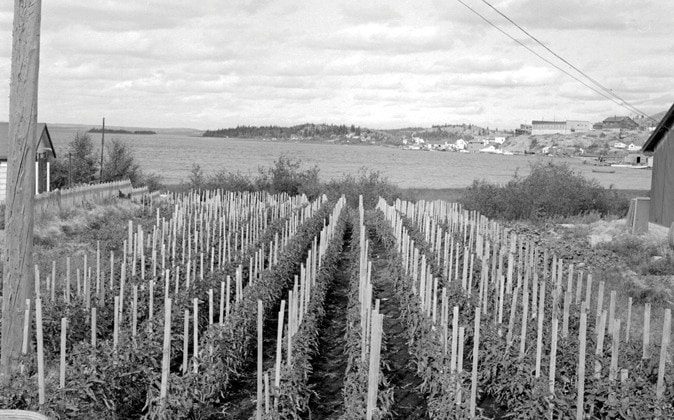House and garden on School Draw. 1950s-1960s. | NWT Archives/©City of Yellowknife/N-1992-170: 0116
Imagine walking up to a row of outdoor vendors, the smell of coffee brewing, baked goods steaming in the morning air. Bounds of high quality, locally grown fresh herbs and vegetables are on offer: lettuce mixes, spinach, kale, radishes, and juicy greenhouse-tendered tomatoes. Smell the whitefish cooking. Browse the selection of chilled fillets, birch syrup, herbal teas gathered from wild plants. There’s art, live music, children dancing…
This is not a description of some established farmer’s market in a warm clime like Vancouver or southern Ontario. This is not a dream (well, technically this broad vision is still somewhat of a dream). This is what is being planned for right here, where we live. Yellowknife!
By day I’m a land and environmental affairs specialist with the GNWT. But I’m also an avid gardener and one of the founding members of the new Yellowknife Commons Collective, a group of civic-minded agriculturalists, business owners and government officials determined to make locally harvested goods available to the public this summer. Come hell or high water.
The idea is not new. From 1994-1997 there was a City Market each Saturday in Trails End near the Racquet Club that featured a flea market along with fish, produce, artists, and plenty of live entertainment. Matthew Grogono, one of its founders, says he had to shut it down when his two partners bailed, but he believes Yellowknife is ripe for a market resurrection, particularly if it could find a waterfront home in Old Town.
The idea gained momentum this time around after local filmmaker and food-grower France Benoit germinated a very specific research idea that I couldn’t turn away. Could Small Plot Intensive farming, known as SPIN farming, be viable in Yellowknife? It’s proven lucrative in other parts of the country, earning people up to $100,000 per season from low-input garden beds. Imagine making a year’s salary by maximizing your production from simple backyard garden beds?
As part of my master’s degree I researched whether Yellowknifers could be SPIN farmers and conducted locally focused interviews to see if there was demand for the fruits and vegetables of their labour. Out of the cross-section of 450 people surveyed, only one said they would not buy local food. Eighty-eight per cent are willing to pay a premium for it, and 96 per cent said they would shop at a farmer’s market.
The research indicates this is viable. Don’t be dismayed by the fact that we live in a city of rock, trees and water. Gardens will grow just lovely here; in fact, it is a significant part of our history.
In the 1930s, when the first gold mines opened in Yellowknife, gardening quickly became an integral component of the economy, providing the bulk of green vegetables essential to the family dinner table. Notable market gardens existed at Giant Mine, Con Mine and the Peace River Flats area. There was also the homestead of Denis and Mildred O’Callaghan, complete with chickens, where Somba K’e Park is now. They later cleared land for a market garden on the stretch between Frame and Niven lakes.
Martin Bode’s garden at Giant successfully cultivated cucumbers, tomatoes, cabbage, cauliflower, carrots, beets, turnips, potatoes, radishes, lettuce, parsley, peas, beans, onions, rhubarb, spinach and Swiss chard, without a greenhouse or any other infrastructure.
Some critics would suggest that we can’t really grow what we need here, but I assure you, northerners are de-mystifying this belief every year. Last summer, Yellowknife’s Arctic Farmer grew a host of beautiful heirloom vegetables inside and out of a greenhouse including peppers, tomatoes, strawberries — even a northern variety of corn. Similarly, Benoit harvested over 50 types of food – everything from cantaloupe to quinoa – without heat, on roughly 1/32 of an acre of land.
Abundant food is being grown in many communities in the NWT. People are redefining models of community economic development — slowly, organically, and symbiotically — in a way that benefits us and our grandchildren, and their children and their children’s children.
So how do we get Yellowknife growing more food?
We take our cues from SPIN farming’s founders, Wally Satzewich and Gail Vandersteen, a couple based out of Saskatoon. They found their market garden business could make more money by ditching the conventional approach to agriculture in the countryside. Growing a wide selection of vegetables on a huge chunk of land requires expensive equipment and high operating costs. Instead, they negotiated with home and business owners for yard space in the city. By specializing their production to only high-value crops — mixed lettuces, garlic, radishes, scallions and spinach — in small pockets of land, they gained efficiencies and reaped higher profits. One of the things that allowed them to do that was tending to their crops by hand.
Hand-driven farms, synonymous with organic farming methods, can be more productive and therefore profitable than conventional farming – don’t believe the propaganda saying otherwise! Research shows that tending to the product by hand instead of with large-scale machinery makes the lands more productive and more resilient to weather phenomena, allowing the farmer to maintain better soil quality and capitalize on the natural contours of the landscape.
Although urban farming in Yellowknife won’t exactly see producers out there tilling up hills of arable soil, we can still be creative with the space we have, utilizing ideal sunny and sheltered locations, implementing vertical gardens on walls and fences, adding greenhouses to rooftops and waste heat sources. People would negotiate the terms of sharing their space to a SPIN farmer; perhaps they’d get a share of the harvest, or just some good karma. Ideally, the farmer would have a water truck and do all of the work so all the landowner has to do is enjoy watching things grow.



Part of my gardening research was to determine whether enough backyards (or enough small spaces) exist in Yellowknife to operate a viable agricultural business and also to assess the cost of operating a low-input commercial garden bed. There is certainly enough space in backyards. In the research participants alone, cumulatively there is roughly 1/6 acre of yard space available in Yellowknife. This is assuming that each participant who identified they had space available for backyard gardening had on average 50 square feet to share. But what’s significantly more promising is the fact that the City is largely undeveloped and has almost 7,000 acres of space that could be assessed for agricultural potential.
Under the SPIN farming approach, one 2-by-25-foot garden bed with a mix of lettuce, spinach, scallions and radish could reap as much as $300, if sequential planting is done effectively and the entire season is utilized. Even in Yellowknife, you might be surprised how long the growing season could be extended with very simple plant covers. A small, plastic hoop cover allows a gardener to plant seeds before the snow melts and harvest produce into October.
Many Yellowknifers noted that seasons appear to be changing and there is a growing opportunity to maximize gardens through the month of September. Jackie Milne in Hay River has demonstrated through a uniquely designed energy-efficient greenhouse that food can grow in the NWT virtually year round with minimal heat input.
According to very approximate numbers, I estimate it is possible to operate 1/6 of an acre on raised beds in Yellowknife at a cost of $20,000. That sounds like a lot, but there is territorial grant money available — enough to cover this entire cost for an interested entrepreneur. If a proactive business could access this money, it implies, based on the SPIN farming guides, that one SPIN farmer (or a co-operative) could profit $27,000 from a seasonal May – September garden business. If more land could be accessed that’s tillable, the expense could be significantly reduced. Compost and nutrients are a challenge, but over the long term this could easily be solved through an expansion of the City’s compost facility, locally housed animals, or the production of fish fertilizer. In the meantime, there is likely more than enough chicken manure in Hay River for all interested gardeners in the region.
All of this encouraging information prompted participants in my survey, local agriculture advocates, businesses and government representatives to get together in Yellowknife last fall to brainstorm a vision for urban farming. We all agreed that we need more land, a farmer’s market and more awareness regarding the potential for local food production. From this the Yellowknife Commons Cooperative arose. In our infancy we are organizing ourselves and preparing to revive a Yellowknife’s Farmers Market for 2013. Dates, times and location are all to be determined. Please contact us if you are interested in growing food to help us stock the market or if you are interested in becoming a member for just a $10 annual fee to help offset local growers’ expenses.
Just think, you may never have to eat a bland tomato trucked from California ever again. We need to be creative, inventive, resourceful and collaborative like our family members and ancestors were before us. This is the future. Best get on with it.
To learn more about the Yellowknife Commons Cooperative or to become a member, contact Amy at amyruthlizotte@gmail.com or 445 9603.






